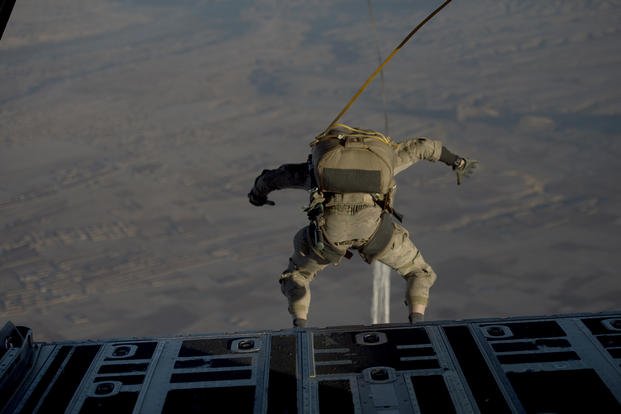Ever thought about getting a little more out of your Air Force career? Or have you ever thought about risking your life to save another? Or going behind enemy lines before anyone else to set on a drop zone/airfield and help call in fire support to troops who need it?
These are just some of the missions of the Air Force Special Tactics -- the parajumpers, or PJs, and combat control technician, or CCT. The PJs are responsible for providing emergency and life-saving services to airmen, soldiers and civilians in peacetime and combat environments. When a plane goes down in the jungle or ocean, PJs are there to find and save the pilots and crew. Pararescuemen live up to their motto: That Others May Live.
The CCTs are Federal Aviation Administration-certified air traffic controllers and responsible for conducting all types of missions behind enemy lines while setting airfields, calling in fire support while working jointly with Army SF, Navy SEALs, etc. The CCT motto is First There; they prep the airfields and drop zones for other troops to follow.
The PAST -- Physical Ability and Stamina Test
To become a PJ or CCT, you must be a proficient swimmer and meet physical standards of at least 100 points on the physical ability and stamina test (PAST). The test consists of three swims, a run and pull-ups, sit-ups and push-ups -- all in a three-hour window. Those jobs are open only to enlisted troops. Here are the specific minimums to becoming a PJ and CCT, but the numbers in parentheses are recommended scores from Spec Ops trainers:
- 2 x 25-meter subsurface swim, no time limit
- 500-meter swim in 10:07 or less (sub-9 minutes)
- 30-minute rest
- 1.5-mile run in 9:47 or less (sub-9 minutes)
- 10-minute rest
- 10 pull-ups minimum (20)
- Two-minute rest
- 58 sit-ups minimum (100)
- Two-minute rest
- 54 push-ups minimum (100)
Iron-man standards:
- 2 x 25 meters subsurface
- 500-meter swim in 9:30
- 1.5-mile run in 9:30
- 13 pull-ups
- 65 sit-ups
- 65 push-ups
These are the minimum scores for the PAST; to be accepted into any Special Force, it takes a higher score to be competitive. I recommend hitting the numbers in parentheses next to the minimum scores.
Once in the PJ Candidate Course, you will be challenged physically for 10 weeks in Joint Base San Antonio-Lackland. The first phase is known as team training and is eight weeks long. It consists of extensive physical training with swimming, running, weight training, calisthenics and obstacle courses. Educational training such as medical and diving terminology, CPR, weapons qualifications and dive physics are also part of the candidate course.
After the candidate course, there are two different professions with two different pipelines (but similar) to follow, depending on whether you want to be a PJ or CCT. Here is the PJ and CCT pipeline of training:
- U.S. Army Airborne School: 3 weeks
- U.S. Army Combat Divers School: 4 weeks
- U.S. Navy Underwater Egress Training: 1 day
- U.S. Air Force Basic Survival School: 2.5 weeks
- U.S. Army Free-fall Parachutist School: 5 weeks
PJ pipeline schools:
- Special Operations Combat Medic Course: 22 weeks
- Pararescue Recovery Specialist Course: 20 weeks
CCT pipeline schools:
- Combat Control Orientation Course, Joint Base San Antonio-Lackland: 10 days
- Combat Control Operator Course: 15.5 weeks
- Combat Control School: 12 weeks
Training is extremely challenging physically and mentally, but if you graduate and wear the maroon beret (PJ) or the scarlet beret (CCT), you will be one of the most highly trained combat medics in the world, able to handle the most stressful situations with ease. Hats off to those who risk their lives to be the First There so That Others May Live.
More Air Force Special Forces articles:
- Air Force Special Tactics fitness training
- Helicopter rescue swimmer training
- Swimming with fins
- SpecOps: Who's toughest?
- All Air Force Special Forces articles
Stew Smith is a former Navy SEAL and fitness author certified as a Strength and Conditioning Specialist (CSCS) with the National Strength and Conditioning Association. Visit his Fitness eBook store if you're looking to start a workout program to create a healthy lifestyle. Send your fitness questions to stew@stewsmith.com.
Want to Learn More About Military Life?
Whether you're thinking of joining the military, looking for fitness and basic training tips, or keeping up with military life and benefits, Military.com has you covered. Subscribe to Military.com to have military news, updates and resources delivered directly to your inbox.



















